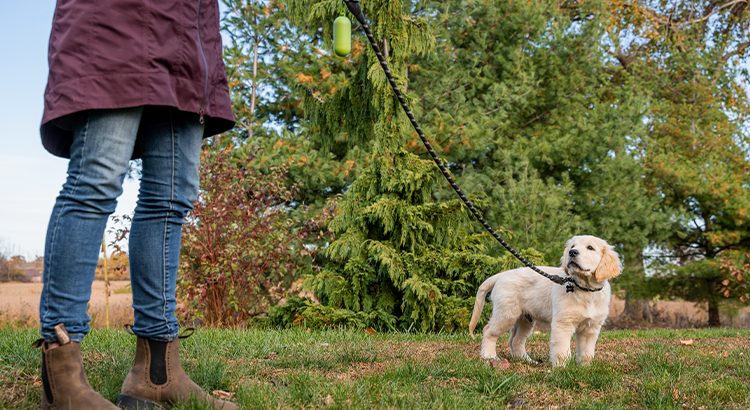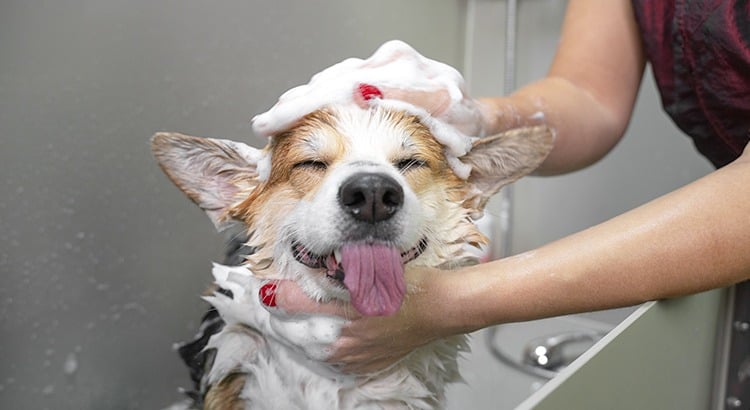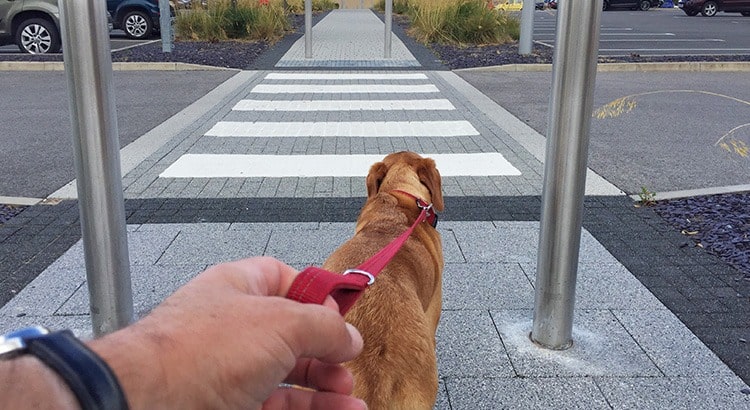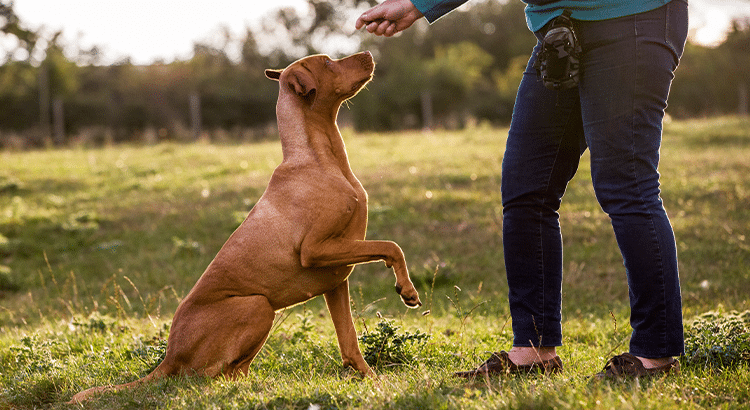
Learn How to Train a Puppy
Regardless of whether you bring a new pet home or are tying to teach an old dog new tricks, there’s some main pointers to follow when training a puppy. While this task requires consistency and positive reinforcement, it can easily be accomplished. The American Kennel Club labels some basics to follow before training a puppy can begin to set your pet up for success. Make sure you create an environment in which your puppy feels safe, and build a positive and trusting relationship with your furry friend.
House Training a Puppy
One of the first goals a new pet owner aims to attain is potty training. It typically takes 4-6 months for a puppy to be fully house trained according to Pet WebMD. An owner must take into account the size of their pet in relation to the size of their bladders. Smaller dogs will require more frequent relief breaks compared to larger pets who may be able to go longer periods of time between potty breaks. You can potty train your pet in three ways:
For potty training, you need to follow these basic tips:
Crate Training
It takes time for pups to get accustomed to crates, but introduce your pup to their crate as soon as possible. Crate training is essential because it makes life easier and creates a familiar space for your pet to retreat in the event they become fearful or just need a nap. Moreover, dog crates are much needed because they can be used for travel, safety, and vet visits. Follow the below-given tips:
Crate training isn’t an easy task, so consistency and positive reinforcement is the key.
Leash Training
It’s challenging to keep young and active puppies on a leash, but it’s essential for their safety. Surprisingly enough, pups can begin learning to walk on a leash as early as 4 to 6 weeks old. Introducing your pup to a leash slowly helps to ease them into this new activity with confidence.
Sit/Stay Training
These are also known as obedience training and are easy to teach with consistency. The “sit” command requires a puppy to plant his tooshie on the floor and remain in position. Training a puppy to “stay” in place can be cued by using the word stay or wait, and also with a hand gesture.
General Tips to Follow for Puppy Training
Remember, training is an ongoing process, so patience and repetition are key.
Training a puppy how to perform the above tasks will help establish a positive pup/ owner relationship. While dogs aim to please, they can also have a wild hair and be an escape artist prior to successful training. With the possibility of becoming lost before adjusting to their new surroundings, a Pin Paws membership improves the likelihood of being reunited faster with your four-legged pet. Sign up today and let us help bring them home.
Table of content
Related articles

Learn How to Train a Puppy
Regardless of whether you bring a new pet home or are tying to teach an old dog new tricks, there’s some main pointers to follow when training a puppy. While this task requires consistency and positive reinforcement, it can easily be accomplished. The American Kennel Club labels some basics to follow before training a puppy can begin to set your pet up for success. Make sure you create an environment in which your puppy feels safe, and build a positive and trusting relationship with your furry friend.
House Training a Puppy
One of the first goals a new pet owner aims to attain is potty training. It typically takes 4-6 months for a puppy to be fully house trained according to Pet WebMD. An owner must take into account the size of their pet in relation to the size of their bladders. Smaller dogs will require more frequent relief breaks compared to larger pets who may be able to go longer periods of time between potty breaks. You can potty train your pet in three ways:
For potty training, you need to follow these basic tips:
Crate Training
It takes time for pups to get accustomed to crates, but introduce your pup to their crate as soon as possible. Crate training is essential because it makes life easier and creates a familiar space for your pet to retreat in the event they become fearful or just need a nap. Moreover, dog crates are much needed because they can be used for travel, safety, and vet visits. Follow the below-given tips:
Crate training isn’t an easy task, so consistency and positive reinforcement is the key.
Leash Training
It’s challenging to keep young and active puppies on a leash, but it’s essential for their safety. Surprisingly enough, pups can begin learning to walk on a leash as early as 4 to 6 weeks old. Introducing your pup to a leash slowly helps to ease them into this new activity with confidence.
Sit/Stay Training
These are also known as obedience training and are easy to teach with consistency. The “sit” command requires a puppy to plant his tooshie on the floor and remain in position. Training a puppy to “stay” in place can be cued by using the word stay or wait, and also with a hand gesture.
General Tips to Follow for Puppy Training
Remember, training is an ongoing process, so patience and repetition are key.
Training a puppy how to perform the above tasks will help establish a positive pup/ owner relationship. While dogs aim to please, they can also have a wild hair and be an escape artist prior to successful training. With the possibility of becoming lost before adjusting to their new surroundings, a Pin Paws membership improves the likelihood of being reunited faster with your four-legged pet. Sign up today and let us help bring them home.

Learn How to Train a Puppy
Regardless of whether you bring a new pet home or are tying to teach an old dog new tricks, there’s some main pointers to follow when training a puppy. While this task requires consistency and positive reinforcement, it can easily be accomplished. The American Kennel Club labels some basics to follow before training a puppy can begin to set your pet up for success. Make sure you create an environment in which your puppy feels safe, and build a positive and trusting relationship with your furry friend.
House Training a Puppy
One of the first goals a new pet owner aims to attain is potty training. It typically takes 4-6 months for a puppy to be fully house trained according to Pet WebMD. An owner must take into account the size of their pet in relation to the size of their bladders. Smaller dogs will require more frequent relief breaks compared to larger pets who may be able to go longer periods of time between potty breaks. You can potty train your pet in three ways:
For potty training, you need to follow these basic tips:
Crate Training
It takes time for pups to get accustomed to crates, but introduce your pup to their crate as soon as possible. Crate training is essential because it makes life easier and creates a familiar space for your pet to retreat in the event they become fearful or just need a nap. Moreover, dog crates are much needed because they can be used for travel, safety, and vet visits. Follow the below-given tips:
Crate training isn’t an easy task, so consistency and positive reinforcement is the key.
Leash Training
It’s challenging to keep young and active puppies on a leash, but it’s essential for their safety. Surprisingly enough, pups can begin learning to walk on a leash as early as 4 to 6 weeks old. Introducing your pup to a leash slowly helps to ease them into this new activity with confidence.
Sit/Stay Training
These are also known as obedience training and are easy to teach with consistency. The “sit” command requires a puppy to plant his tooshie on the floor and remain in position. Training a puppy to “stay” in place can be cued by using the word stay or wait, and also with a hand gesture.
General Tips to Follow for Puppy Training
Remember, training is an ongoing process, so patience and repetition are key.
Training a puppy how to perform the above tasks will help establish a positive pup/ owner relationship. While dogs aim to please, they can also have a wild hair and be an escape artist prior to successful training. With the possibility of becoming lost before adjusting to their new surroundings, a Pin Paws membership improves the likelihood of being reunited faster with your four-legged pet. Sign up today and let us help bring them home.



